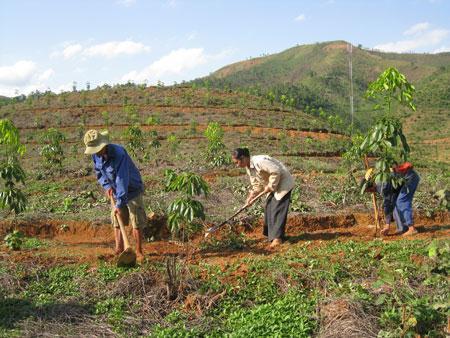Nguyen Vinh Quang from Forest Trends, representing the research team which conducted a quick survey in three provinces of Son La, Dien Bien and Lai Chau in February and March 2019, affirmed that real income from rubber farming was much lower than income from other crops on the same land area.

About 75 percent of surveyed households said their income decreased after contributing land to grow rubber, while 47 percent said the income fell by at least 40 percent.
After eight years of farming, the profit from rubber latex was VND500,000-2 million per hectare, which was just equal to 2 percent of profits from maize. The income may increase in the future with the latex output increase, but it will be lower than the income from other crops.
More than 50 percent of households said they wanted to fell rubber trees to cultivate other crops.
According to Lo Van Dien from Muong Bu commune in Son La province, locals contributed 300 hectares of land, but they have not received any dong in dividends. Lu Van Hai from Ta Mo Hamlet said locals were unhappy because they have not received significant benefits from the project.
|
About 75 percent of surveyed households said their income decreased after contributing land to grow rubber, while 47 percent said the income fell by at least 40 percent. |
He said the recruitment of workers for rubber plantations did not go as promised (1 worker for 1 hectare, VND1.5-1.8 million a month). Workers could not get official labor contracts after two years of working, while the number of poor households in the hamlet has increased to 50 percent.
Lo Van Hung from Cu Pe hamlet said he now just wants to get his land back, because he ‘could not get any benefit from the land contribution over the last 11 years’.
Hung believes that rubber trees ‘won’t have a future’ in Son La, because it cannot bear the severe weather conditions there. “Rubber trees will die when white fog appears,” he said.
Prof Nguyen Ngoc Lung also thinks rubber trees will not develop well in the northwest because the tree grows well at the height of below 60 meters and in temperatures of 22oC and higher. The land area satisfying both conditions in the northwest is very modest.
Meanwhile, Ho Anh Duc from Son La Rubber Company and Nguyen Hong Thang, director of Lai Chau Rubber, did not give direct reply to complaints by locals, but said it would be better to find solutions to problems rather than continue complaining.
According to Thang, the Vietnam Rubber Group has built a 5,000 ton plant in Son La and is going to build other plants in Lai Chau and DIen Bien.
RELATED NEWS
Vietnam struggles to stay in top 3 rubber exporters
Natural rubber market struggles
Nam Lich
 Social organizations and the Vietnam Rubber Group are arguing about farmers’ contribution of land for rubber production in northwestern provinces.
Social organizations and the Vietnam Rubber Group are arguing about farmers’ contribution of land for rubber production in northwestern provinces.